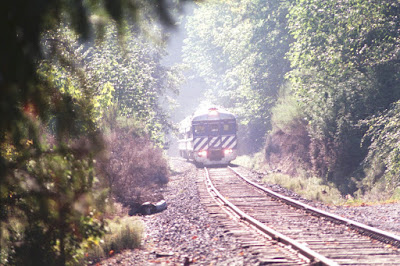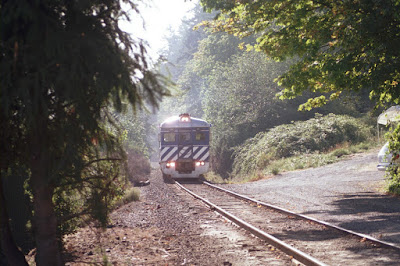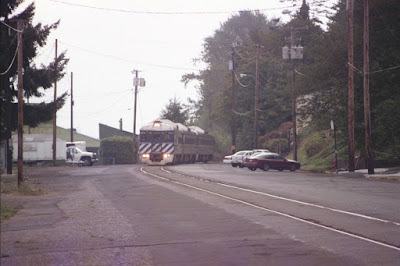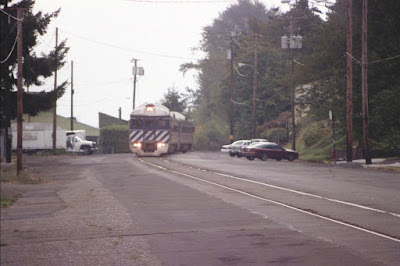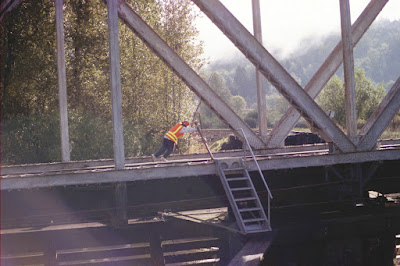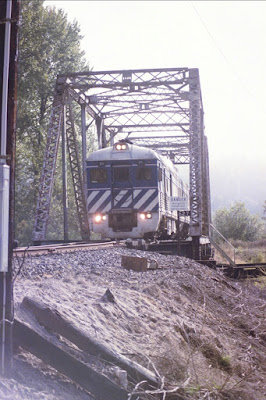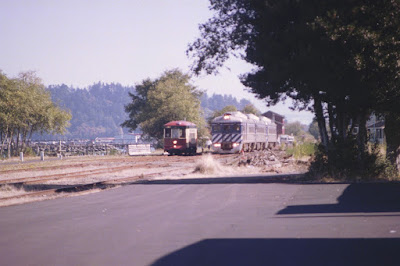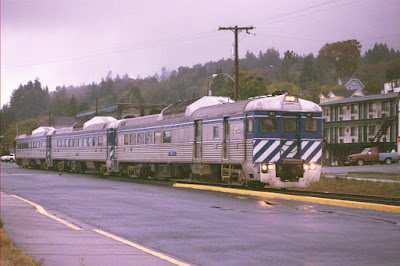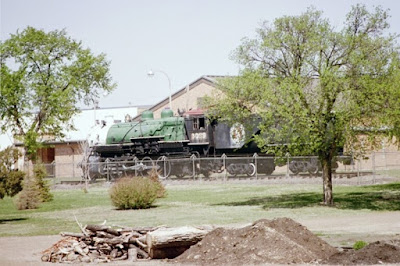Willamette & Pacific GP39-2 #2310 “Monroe” is a 2,300-horsepower GP39-2 that was built by the Electro-Motive Division of General Motors in August 1974 as Atchison, Topeka & Santa Fe #3609. It was retired in December 1992 and was sold to the Willamette & Pacific Railroad in June 1993. It is pictured here at Saint Helens, Oregon, on October 1, 2005.
Pages
Tuesday, December 26, 2023
Lewis & Clark Explorer in 2005
Leading the train, ORRX #31 is an RDC-3 originally built by Budd in July 1956 for the Great Northern Railway as #2350. The RDC-3 featured a section at one end of the car for baggage and mail. #2350 became Burlington Northern #2350 in 1970 and later became Amtrak #43. The British Columbia Railway purchased the car in January 1976 to replace their original #BC-31, which was destroyed in a fire on November 26, 1973. Trailing behind, ORRX #10 & #11 are RDC-1s built in August 1956 by Budd for British Columbia Railway's predecessor Pacific Great Eastern as #BC-10 and #BC-11. The RDC-1 was the passenger-only model of Budd's RDC line. The Pacific Great Eastern became the British Columbia Railway on April 1, 1972, when it was taken over by British Columbia's provincial government. The railroad began going by the name BC Rail on June 19, 1984. These RDC's are still in BC Rail paint, with only the BC Rail heralds replaced by the Lewis & Clark Explorer heralds.
How the three RDCs were coupled together varied. Sometimes the RDC-3 #31 was at one end, other times it was in the middle. The three were rarely separated, so they remained as they were coupled for quite a while.
Clatskanie takes its name from the Tlatskanai Indians, a very warlike tribe that inhabited this area. The Tlatskanai were wiped out by a smallpox epidemic in the 1850s. Clatskanie was first settled in 1852. It was originally called Bryantville. Clatskanie was incorporated in 1891. According to the 2000 census, Clatskanie has a population of 1,528 people. Unlike the other towns, which the railroad runs right through the middle of, the railroad only skirts along the edge of Clatskanie. At the west end of town, the railroad crosses the Clatskanie River on a swing-type drawbridge built in 1897.
This bridge must be manually swung by a handcrank in the center of the span. This is the first of three manual drawbridges the train crosses. The bridge is normally kept open for river traffic, and is only swung closed when a train is waiting.
This is the bridge at which the Portland & Western freight train crew switching the Stimson Lumber mill at Clatskanie pushed a carload of lumber off the approach to the open drawbridge into the river on September 2, 2004. The train was operating on the east side of the bridge, so in the pictures it is the far approach that was damaged. Since the bridge was completely open at the time, the main span was not damaged.
This damage to the bridge approach closed the line for the entire Labor Day weekend, forcing that weekend's trips of the Lewis & Clark Explorer to be cancelled. The bridge approach was repaired and the line reopened in time for the rest of the season to be completed.
John West settled in Westport in 1850. The post office opened in 1863. Westport is located on Westport Slough, a side channel of the Columbia River. This location shelters the shore at Westport from the current in the river's main channel, making the slough a relatively good place for boaters and fishermen. Since 1925, a car ferry has connected Westport with Puget Island. This small ferry operation proves itself essential when construction or another emergency temporarily closes one of the bridges at Rainier or Astoria. This picture shows the westbound Lewis & Clark Explorer as it moves through Westport.
The town of Knappa was named after Aaron Knapp, Jr., an early settler of the area. The Knappa post office operated from 1873 to 1943. The actual town of Knappa is actually a little inland from the river, and the railroad stays close to the river here and doesn't actually go through Knappa. Two roads cross the railroad at Knappa. Knappa Road crosses above the tracks on an old wooden overpass. Waterhouse Road crosses the tracks at a traditional grade crossing. But this grade crossing is unique; it is still protected by an antique railroad crossing signal known as a Magnetic Flagman or wigwag.
Just north of the tracks, Waterhouse Road turns to intersect with Knappa Road, which is just to the east. The Knappa Road overpass is adjacent to the Waterhouse Road crossing, making this a very photogenic spot for train photographs. Unfortunately, the Portland & Western has no freight business this far down the line, so without the Lewis & Clark Explorer train, this area sees almost no rail traffic.
This type of signal was manufactured by the Magnetic Signal Company of Los Angeles, California from 1910 to 1949. It takes its name from the movement it makes; the black and white banner with the red light in the middle swings, "wigwags" back and forth. The movement is similar to that made by a human flagman while swinging a flag or lantern to stop traffic. The signal also features a bell. This wigwag was removed in March of 2007.
Astoria is the oldest settlement west of the Rocky Mountains. Fur traders sent by John Jacob Astor built Fort Astoria in 1811. Astoria is the county seat of Clatsop County. According to the 2000 census, Astoria has a population of 9,813 people.
The tracks along the waterfront through Astoria are used by the Astoria Riverfront Trolley.
The Lewis & Clark Explorer's journey ends, appropriately enough, in front of the old Astoria railroad depot. The depot was built in 1924, the peak year for rail travel in Astoria. The railroad continued to use the building for decades after passenger service ended, but today the building is owned by the Columbia River Maritime Museum. It is closed to the public as it is in need of serious repair and is only used for storage.
After leaving the street-running behind, the railroad crosses over Fox Creek on an old wooden trestle that probably dates from the railroad's original construction in the 1890s.
Monday, December 18, 2023
Astoria Riverfront Trolley #300
Astoria Riverfront Trolley #300 operates on a 3-mile section of the former Spokane, Portland & Seattle Railway's Astoria Line that the city of Astoria purchased from Burlington Northern in 1996, before the remaining 92 miles of the line were sold to the Portland & Western Railroad in 1997.
Trolley #300 was the first of a group of 14 built for the San Antonio Traction Company in 1913 by the American Car Company of St. Louis, Missouri. This group of cars had composite bodies of wood and steel, while an additional 12 cars built in1914 has all steel bodies. In 1917 the San Antonio Traction Company became part of the San Antonio Public Service Company. San Antonio streetcar service officially ended on April 29, 1933, and that same day Trolley #300 was presented to the Witte Museum, a precursor of the San Antonio Museum Association, and was run onto the museum grounds under its own power and parked, where it would remain on outdoor static display until 1948, when it was housed in a structure and superficially restored. After the 1968 San Antonio World's Fair, a new transportation museum was developed at the downtown fairgrounds, and Trolley #300 was placed on outdoor display to rot until 1980. The car was restored in 1980 and 1981 using parts from the body of car #311, which had been used as a residence after its 1933 retirement until 1978. The car was converted to standard gauge using trucks from New Orleans, and the original 4-foot gauge trucks were saved for another San Antonio Trolley under restoration. In October 1982, the restored Trolley returned to operation, providing public rides on a short section of track behind the San Antonio Museum of Art until the operation was discontinued in late 1985 due to a lack of funding and the Trolley was again stored.
Gales Creek Enterprises leased the Trolley from the San Antonio Museum Association and brought it to Oregon in June 1990 for use on the Willamette Shore Trolley line between Portland and Lake Oswego.
Willamette Shore Trolley service began July 6, 1990, operated by Paul Class and Gales Creek Enterprises through the end of 1994. Meanwhile, the San Antonio Museum Association was dissolved in 1994 and the San Antonio Museum of Art became the trolley’s new owner.
In 1995, the Oregon Electric Railway Historical Society took over the operation of the Willamette Shore Trolley. Trolley #300 left the Willamette Shore Trolley line and was stored outdoors at the Oregon Electric Railway Museum’s Trolley Park in Glenwood, Oregon, remaining there after the Trolley Park closed and the OERHS moved to Powerland Heritage Park in Brooks, Oregon in 1996. Trolley #300 was eventually leased by the Astoria Riverfront Trolley Association in November, 1998, and it was moved to Astoria in December 1998 for restoration. Trolley #300 has operated in Astoria since June 8, 1999 and was purchased from the San Antonio Museum of Art by the Astoria Riverfront Trolley Association in August 2005.
Sunday, December 17, 2023
Espresso Express Caboose in Longview, Washington
This old caboose turned espresso stand is located at 745 Ocean Beach Highway in Longview, Washington. According to owners Dan & Laura Estey, it was built in 1933 for the Northern Pacific Railway, and it was eventually acquired by the Weyerhaeuser Woods Railroad as their #6 and was used on log trains around Longview. Dan & Laura Estey purchased it from Weyerhaeuser in 1996 and kept "Old #6's" Weyerhaeuser number.
Sunday, November 26, 2023
St. Lawrence & Atlantic (LLPX) GP40 #3208 in Rainier, Oregon, in the summer of 2005

The seven locomotives were sold to Toronto’s GO Transit in 1982. This locomotive became GO Transit #721. As they were not equipped with head-end power generators, they had to operate with HEP cars rebuilt from F-units. In 1994 they were retired and traded in to EMD for new F59PHs. EMD put the locomotives in their lease fleet and this locomotive became EMDX #205.
This locomotive appeared on the Portland & Western’s Astoria Line in the summer of 2005, where I photographed it parked on the trestle over Fox Creek in Rainier, Oregon. I took several pictures, expecting that it would either leave soon to never be seen again, or be repainted. Soon after these photos were taken, it became Portland & Western #3006, with large P&W heralds applied over the St. Lawrence & Atlantic black and yellow paint, and would remain that way for nearly a decade before finally being repainted in Genesee & Wyoming’s standard orange & black paint scheme in 2013 or 2014.
Incidentally, the St. Lawrence & Atlantic yellow and black paint scheme is not dissimilar to the Pullman green and yellow paint scheme used by the Spokane, Portland & Seattle Railway, which operated the Astoria Line prior to the Burlington Northern merger of 1970, and had ordered similar-looking GP38s just before the merger that ended up being delivered in BN Cascade Green. If you don’t look too close, this locomotive is almost a glimpse of what might have been.
Sunday, November 5, 2023
Great Northern 2-8-2 #3059 in Williston, North Dakota, in May 2004
My dad, Cliff West, took this pictures of Great Northern O-1 Class 2-8-2 #3059 from the train during the westbound Empire Builder’s station stop at Williston, North Dakota, in May 2004. The Great Northern had a total of 145 O-1 Class 2-8-2 Mikados built by the Baldwin Locomotive Works in four groups between August 1911 and February 1919, and the last of them were retired in April 1958. Built in February 1913, #3059 was one of the last 15 in operation when it was retired in December 1957, and is the only survivor. It was donated to the City of Williston and placed on display in Railroad Park on August 2, 1958.
Portland & Western GP39-2 #2305 Dallas in Rainier, Oregon in Spring 2004
Its paint job features banners reading “Celebrating 10 Years 1993-2003” commemorating the 10th anniversary of the formation of the Willamette & Pacific Railroad. My dad, Cliff West, photographed it with a local freight train at the short trestle over Fox Creek in Rainier, Oregon in the Spring of 2004.
1997 MSOE Society of Model Engineers New Member Orientation Program
These pictures were taken at various locations in the Milwaukee area during the Milwaukee School of Engineering Society of Model Engineers New Member Orientation Program in December 1997, and were saved from the SOME files. All of these locations have some connection to trains.

This bridge in the Milwaukee suburb of Wauwatosa, Wisconsin, was built in 1910 by the Cleary-White Construction Company of Chicago for the Milwaukee, Sparta & Northwestern Railroad, as part of a 9-mile double track line that opened in 1911 from West Allis north to Butler, location of a 21-track yard with a capacity of 1500 freight cars intended to relieve congestion from the yards in downtown Milwaukee. The 175-foot 7-panel riveted Parker through truss main span was built by the Pennsylvania Steel Company of Steelton, Pennsylvania, and carried the railroad over the route completed in 1855 by the Milwaukee & Watertown Railroad, a predecessor of the Chicago, Milwaukee, St. Paul and Pacific Railroad. Four approach spans built by the American Bridge Company of New York extend the bridge to a total length of 490 feet, crossing Underwood Creek and Watertown Plank Road, which began as a toll road in the 1830s. In 1912, the Milwaukee, Sparta & Northwestern Railroad was taken over by the Chicago & North Western Railway, which was merged into the Union Pacific Railroad in 1995. Meanwhile, the Chicago, Milwaukee, St. Paul & Pacific Railroad was purchased by the Soo Line Railroad in 1985, which was subsequently absorbed by its parent company Canadian Pacific in 1992.




